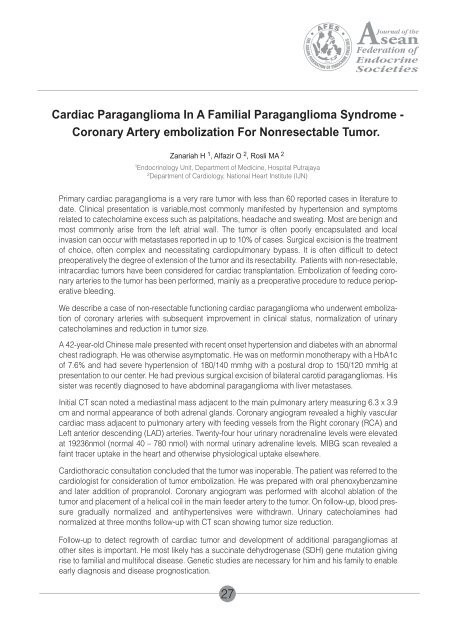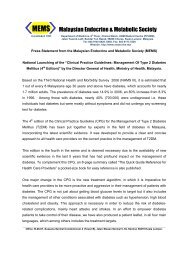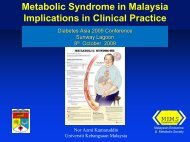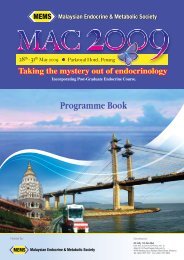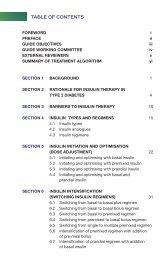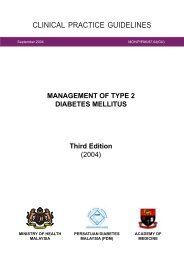JAFES-Booklet (English - pdf - 1103 Kb) - MEMS
JAFES-Booklet (English - pdf - 1103 Kb) - MEMS
JAFES-Booklet (English - pdf - 1103 Kb) - MEMS
You also want an ePaper? Increase the reach of your titles
YUMPU automatically turns print PDFs into web optimized ePapers that Google loves.
Cardiac Paraganglioma In A Familial Paraganglioma Syndrome -<br />
Coronary Artery embolization For Nonresectable Tumor.<br />
Zanariah H 1 , Alfazir O 2 , Rosli MA 2<br />
1 Endocrinology Unit, Department of Medicine, Hospital Putrajaya<br />
2 Department of Cardiology, National Heart Institute (IJN)<br />
Primary cardiac paraganglioma is a very rare tumor with less than 60 reported cases in literature to<br />
date. Clinical presentation is variable,most commonly manifested by hypertension and symptoms<br />
related to catecholamine excess such as palpitations, headache and sweating. Most are benign and<br />
most commonly arise from the left atrial wall. The tumor is often poorly encapsulated and local<br />
invasion can occur with metastases reported in up to 10% of cases. Surgical excision is the treatment<br />
of choice, often complex and necessitating cardiopulmonary bypass. It is often difficult to detect<br />
preoperatively the degree of extension of the tumor and its resectability. Patients with non-resectable,<br />
intracardiac tumors have been considered for cardiac transplantation. Embolization of feeding coronary<br />
arteries to the tumor has been performed, mainly as a preoperative procedure to reduce perioperative<br />
bleeding.<br />
We describe a case of non-resectable functioning cardiac paraganglioma who underwent embolization<br />
of coronary arteries with subsequent improvement in clinical status, normalization of urinary<br />
catecholamines and reduction in tumor size.<br />
A 42-year-old Chinese male presented with recent onset hypertension and diabetes with an abnormal<br />
chest radiograph. He was otherwise asymptomatic. He was on metformin monotherapy with a HbA1c<br />
of 7.6% and had severe hypertension of 180/140 mmhg with a postural drop to 150/120 mmHg at<br />
presentation to our center. He had previous surgical excision of bilateral carotid paragangliomas. His<br />
sister was recently diagnosed to have abdominal paraganglioma with liver metastases.<br />
Initial CT scan noted a mediastinal mass adjacent to the main pulmonary artery measuring 6.3 x 3.9<br />
cm and normal appearance of both adrenal glands. Coronary angiogram revealed a highly vascular<br />
cardiac mass adjacent to pulmonary artery with feeding vessels from the Right coronary (RCA) and<br />
Left anterior descending (LAD) arteries. Twenty-four hour urinary noradrenaline levels were elevated<br />
at 19236nmol (normal 40 – 780 nmol) with normal urinary adrenaline levels. MIBG scan revealed a<br />
faint tracer uptake in the heart and otherwise physiological uptake elsewhere.<br />
Cardiothoracic consultation concluded that the tumor was inoperable. The patient was referred to the<br />
cardiologist for consideration of tumor embolization. He was prepared with oral phenoxybenzamine<br />
and later addition of propranolol. Coronary angiogram was performed with alcohol ablation of the<br />
tumor and placement of a helical coil in the main feeder artery to the tumor. On follow-up, blood pressure<br />
gradually normalized and antihypertensives were withdrawn. Urinary catecholamines had<br />
normalized at three months follow-up with CT scan showing tumor size reduction.<br />
Follow-up to detect regrowth of cardiac tumor and development of additional paragangliomas at<br />
other sites is important. He most likely has a succinate dehydrogenase (SDH) gene mutation giving<br />
rise to familial and multifocal disease. Genetic studies are necessary for him and his family to enable<br />
early diagnosis and disease prognostication.<br />
27


